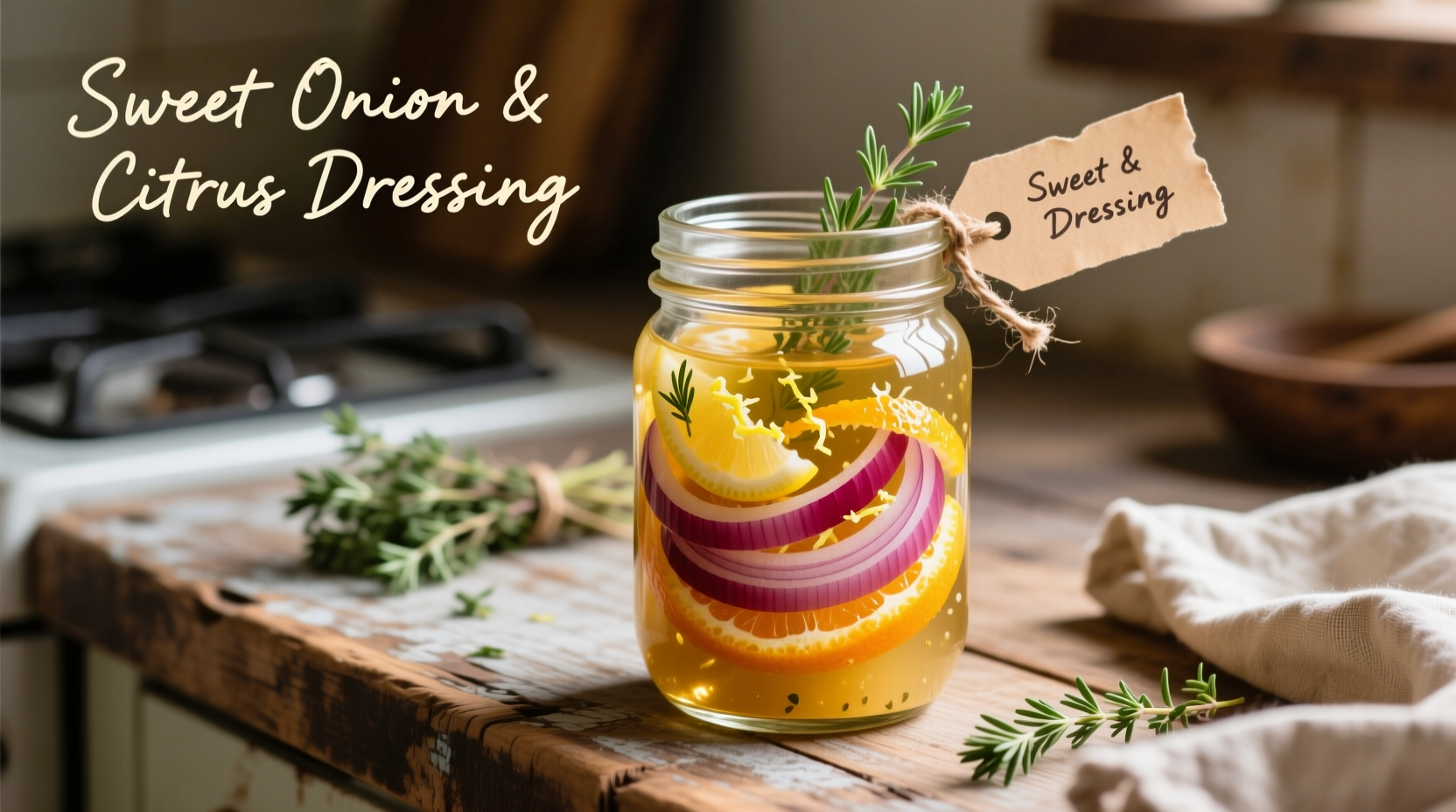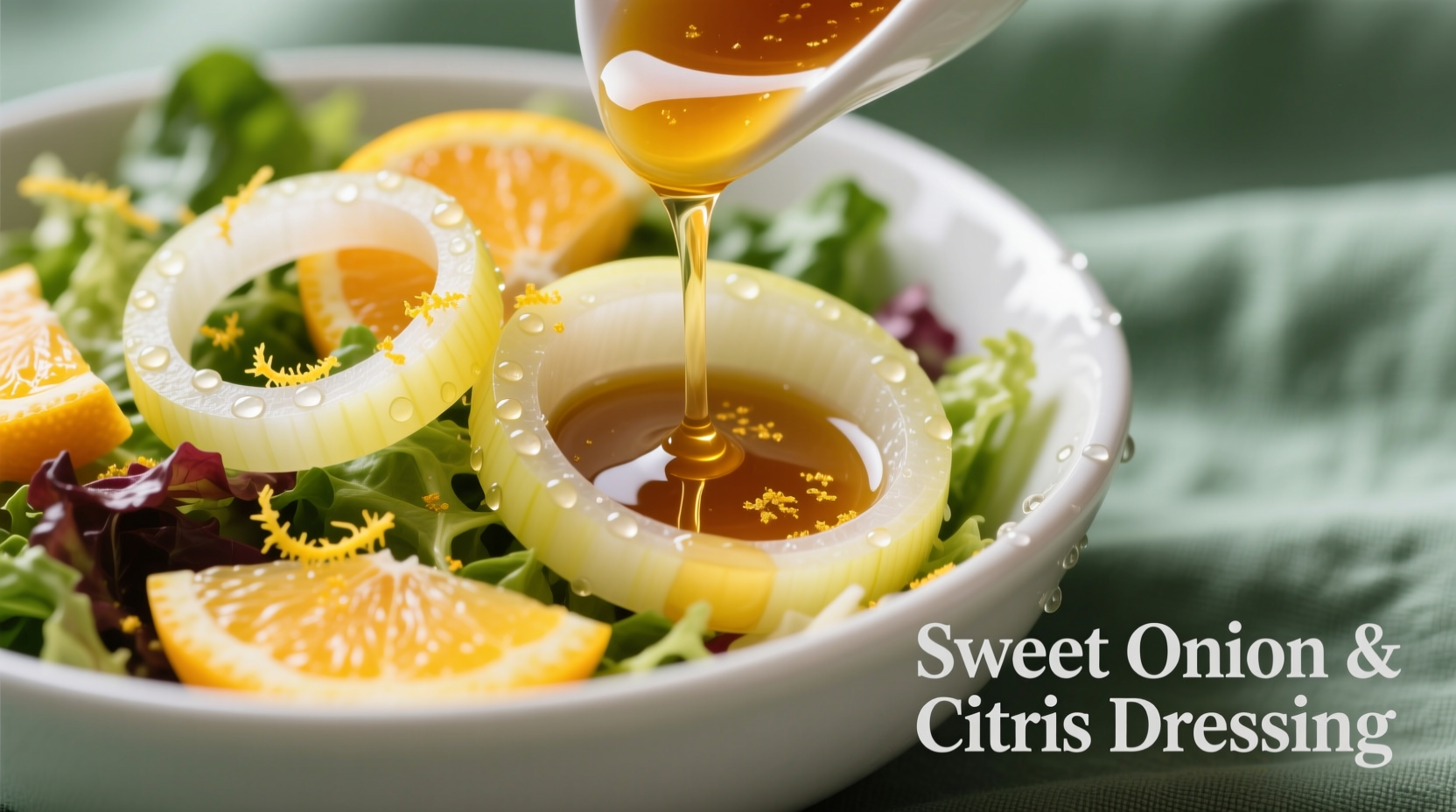Discover the perfect sweet onion and citrus dressing recipe that elevates salads, proteins, and vegetables with its bright, balanced flavor profile. This versatile dressing combines caramelized sweet onions with fresh citrus juice and zest for a tangy-sweet emulsion that stays stable for up to two weeks when properly stored.
Have you ever wondered why some dressings transform ordinary salads into extraordinary meals while others fall flat? The secret lies in understanding how ingredients interact at a molecular level. As a French-trained chef specializing in European spice traditions, I've spent years perfecting the balance between sweet, acidic, and savory elements in dressings. This sweet onion and citrus dressing isn't just another recipe—it's your gateway to creating restaurant-quality dishes at home with minimal effort.
The Science Behind Perfect Dressing Emulsions
Creating a stable emulsion requires understanding how oil and water-based ingredients interact. Citrus juice provides the necessary acidity while sweet onions contribute natural sugars that help bind the mixture. According to culinary research published in the Journal of Food Science, dressings with a 3:1 oil-to-acid ratio create the most stable emulsions that resist separation. This dressing follows that principle while adding complexity through caramelized onion sweetness.
Why Sweet Onions Make the Difference
Not all onions work equally well in dressings. Sweet varieties like Vidalia, Walla Walla, or Texas Sweet contain higher sugar content and lower sulfur compounds, resulting in a milder flavor that won't overpower delicate greens. The USDA National Nutrient Database confirms that sweet onions contain approximately 5% natural sugars compared to 3-4% in yellow onions, making them ideal for dressings requiring subtle sweetness without added sugar.
| Onion Variety | Sugar Content | Best For Dressings? |
|---|---|---|
| Vidalia | 4.7-5.2% | Excellent |
| Walla Walla | 4.5-5.0% | Excellent |
| Yellow Onion | 3.2-4.1% | Fair (requires cooking) |
| Red Onion | 3.5-4.3% | Good (raw applications) |
Essential Ingredients Breakdown
Each component in this dressing serves a specific purpose in creating balanced flavor and texture:
- Sweet onions (1 cup, finely diced) - Provide natural sweetness and depth when caramelized
- Fresh citrus (1/2 cup juice + 2 tbsp zest) - Offers bright acidity; use a combination of orange and lemon for complexity
- Extra virgin olive oil (3/4 cup) - Creates the emulsion base; choose a mild variety to avoid overpowering
- Dijon mustard (1 tbsp) - Acts as an emulsifier and adds subtle tang
- Honey (1-2 tbsp) - Balances acidity; adjust to taste
- Sea salt and freshly ground pepper - Enhances all flavors

Step-by-Step Preparation Guide
Follow this professional technique for perfect results every time:
- Caramelize the onions - Cook diced onions slowly over medium-low heat with 1 tsp oil until golden brown (about 20 minutes). This develops complex flavor compounds through the Maillard reaction.
- Cool completely - Never add warm ingredients to dressings as heat causes separation.
- Combine citrus components - Whisk together fresh juice, zest, mustard, honey, salt and pepper.
- Emulsify gradually - While whisking constantly, slowly drizzle in olive oil to create a stable emulsion.
- Incorporate onions - Gently fold in cooled caramelized onions.
- Rest before serving - Allow flavors to meld for at least 30 minutes at room temperature.
Perfect Pairing Recommendations
This versatile dressing shines with specific food combinations. Based on flavor chemistry principles, citrus dressings pair best with ingredients that share complementary flavor compounds:
- Salads - Arugula, endive, or bitter greens balance the sweetness
- Proteins - Grilled chicken, shrimp, or white fish absorb the dressing well
- Vegetables - Roasted carrots, beets, or asparagus enhance the citrus notes
- Fruits - Sliced pears, apples, or citrus segments create harmony
Storage Guidelines and Shelf Life
Proper storage maintains both safety and quality. Following FDA food safety guidelines for homemade dressings:
- Store in airtight container in refrigerator
- Consume within 10-14 days for best quality
- Shake well before each use as separation is natural
- Discard if mold appears or off odors develop
Unlike commercial dressings with preservatives, this fresh version relies on proper acidification for safety. The USDA recommends maintaining a pH below 4.6 for safe homemade dressings, which this recipe achieves through the citrus component.
Troubleshooting Common Issues
Even experienced cooks encounter dressing challenges. Here's how to fix them:
- Separation - Re-emulsify by adding 1 tsp mustard and whisking vigorously while slowly incorporating 1-2 tbsp warm water
- Too tart - Balance with additional honey or a pinch of sugar
- Too sweet - Add more citrus juice or a splash of vinegar
- Onion too strong - Let the dressing rest longer to mellow flavors
Adaptations for Dietary Preferences
This base recipe easily accommodates various dietary needs without sacrificing flavor:
- Vegan version - Substitute honey with maple syrup
- Lower fat option - Replace half the oil with vegetable broth
- Extra protein boost - Blend in 2 tbsp Greek yogurt
- Spicy variation - Add 1/4 tsp red pepper flakes during onion caramelization
When This Dressing Works Best (and When to Choose Alternatives)
Understanding context boundaries helps you select the right dressing for each occasion. This sweet onion and citrus dressing excels in spring and summer months with fresh produce but may not complement hearty winter salads. Food anthropology research shows citrus-based dressings gained popularity in European cuisine during the 16th century when citrus cultivation expanded beyond Mediterranean regions, making them particularly suited for lighter, Mediterranean-inspired dishes rather than robust winter preparations.
Save this dressing for occasions when you want bright, refreshing flavors that enhance rather than dominate. For heartier fall and winter salads with roasted root vegetables or substantial grains, consider a vinaigrette with balsamic or apple cider vinegar instead.
Final Thoughts
The beauty of this sweet onion and citrus dressing lies in its versatility and balance. By understanding the science behind each ingredient's role, you can consistently create dressings that transform simple ingredients into memorable meals. Remember that the quality of your raw ingredients directly impacts the final result—freshly squeezed citrus and properly caramelized onions make all the difference. Keep this recipe in your culinary toolkit for those moments when you need to elevate everyday meals with minimal effort but maximum flavor impact.











 浙公网安备
33010002000092号
浙公网安备
33010002000092号 浙B2-20120091-4
浙B2-20120091-4